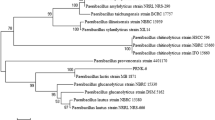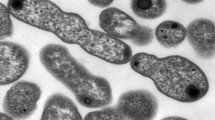Abstract
The fusant strain (F14), which produced by protoplast fusion between Sphingomonas sp. GY2B (GenBank DQ139343) and Pseudomonas sp. GP3A (GenBank EU233280), was tested for phenanthrene biodegradation at 30 °C and pH of 7.0. The kinetics of phenanthrene biodegradation by F14 was investigated over a wide range of initial concentration (15–1,000 mg l−1). The rate and the extent of phenanthrene degradation increased with the increase of concentration up to 230 mg l−1, which indicated negligible inhibition effect at low concentrations. The non-competitive inhibition model was found to be fit for the process. GC–MS analysis showed that biodegradation of phenanthrene by F14 was via dioxygenation at both 1,2- and 3,4-positions and followed by 2-hydroxy-1-naphthoic acid and 1-hydroxy-2-naphthoic acid. The relative intensity of 2-hydroxy-1-naphthoic acid was approximately 3–4 times higher than that of 1-hydroxy-2-naphthoic acid, indicating the 2-hydroxy-1-naphthoic acid was the predominant product in the phenanthrene degradation by fusant strain F14.



Similar content being viewed by others
References
Balashova NV, Kosheleva IA, Golovchenko NP, Boronin AM (1999) Phenanthrene metabolism by Pseudomonas and Burkholderia strains. Process Biochem 35:291–296
Carney MW, Erwin K, Hardman R, Yuen B, Volz DC, Hinton DE, Kullman SW (2008) Differential developmental toxicity of naphthoic acid isomers in medaka (Oryzias latipes) embryos. Mar Pollut Bull 57:255–266
Chen XP, Yi XY, Tao XQ, Wu RR, Yang C, Dang Z (2008) Screening and characterization of pyrene-degrading microbial. Chin J Environ Eng 3:413–417
Doddamani HP, Ninnekar HZ (2000) Biodegradation of phenanthrene by a Bacillus species. Curr Microbiol 41:11–14
Ghosal D, Chakraborty J, Khara P, Dutta TK (2010) Degradation of phenanthrene via meta-cleavage of 2-hydroxy-1-naphthoic acid by Ochrobactrum sp. strain PWTJD. FEMS Microbiol Lett 313:103–110
Heitkamp MA, Cerniglia CE (1988) Mineralization of polycyclic aromatic hydrocarbons by a bacterium isolated from sediment below an oil field. Appl Environ Microbiol 54:1612–1614
Kargi F, Eker S (2004) Toxicity and batch biodegradation kinetics of 2,4 dichlorophenol by pure Pseudomonas putida culture. Enzyme Microb Technol 35:424–428
Mallick S, Chatterjee S, Dutta TK (2007) A novel degradation pathway in the assimilation of phenanthrene by Staphylococcus sp. strain PN/Y via meta-cleavage of 2-hydroxy-1-naphthoic acid: formation of trans-2, 3-dioxo-5-(2′-hydroxyphenyl)-pent-4-enoic acid. Microbiology 153:2104–2115
Moody JD, Freeman JP, Doerge DR, Cerniglia CE (2001) Degradation of phenanthrene and anthracene by cell suspensions of Mycobacterium sp. strain PYR-1. Appl Environ Microbiol 67:1476–1483
Onysko KA, Budman HM, Robinson CW (2000) Effect of temperature on the inhibition kinetics of phenol biodegradation by Pseudomonas putida Q5. Biotechnol Bioeng 70:291–299
Pamukoglu MY, Kargi F (2008) Biodegradation kinetics of 2,4,6-trichlorophenol by Rhodococcus rhodochrous in batch culture. Enzyme Microb Technol 43:43–47
Parikh SJ, Chorover J, Burgos WD (2004) Interaction of phenanthrene and its primary metabolite (1-hydroxy-2-naphthoic acid) with estuarine sediments and humic fractions. J Contam Hydrol 72:1–22
Peng RH, Xiong AS, Xue Y, Fu XY, Gao F, Zhao W, Tian YS, Yao QH (2008) Microbial biodegradation of polyaromatic hydrocarbons. FEMS Microbiol Rev 32:927–955
Pinyakong O, Habe H, Omori T (2003) The unique aromatic catabolic genes in sphingomonads degrading polycyclic aromatic hydrocarbons (PAHs). J Gen Appl Microbiol 49:1–19
Pinyakong O, Habe H, Supaka N, Pinpanichkarn P, Juntongjin K, Yoshida T, Furihata K, Nojiri H, Yamane H, Omori T (2000) Identification of novel metabolites in the degradation of phenanthrene by Sphingomonas sp. strain P2. FEMS Microbiol Lett 191:115–121
Prabhu Y, Phale P (2003) Biodegradation of phenanthrene by Pseudomonas sp. strain PP2: novel metabolic pathway, role of biosurfactant and cell surface hydrophobicity in hydrocarbon assimilation. Appl Microbiol Biotechnol 61:342–351
Seo JS, Keum YS, Hu Y, Lee SE, Li QX (2007) Degradation of phenanthrene by Burkholderia sp. C3: initial 1, 2-and 3, 4-dioxygenation and meta-and ortho-cleavage of naphthalene-1,2-diol. Biodegradation 18:123–131
Seo JS, Keum YS, Hu Y, Lee SE, Li QX (2006) Phenanthrene degradation in Arthrobacter sp. P1-1: initial 1, 2-, 3, 4-and 9, 10-dioxygenation, and meta-and ortho-cleavages of naphthalene-1, 2-diol after its formation from naphthalene-1, 2-dicarboxylic acid and hydroxyl naphthoic acids. Chemosphere 65:2388–2394
Seo JS, Keum YS, Li QX (2009) Bacterial degradation of aromatic compounds. Int J Environ Res Public Health 6:278–309
Tao XQ, Lu GN, Dang Z, Yang C, Yi XY (2007) A phenanthrene-degrading strain Sphingomonas sp. GY2B isolated from contaminated soils. Process Biochem 42:401–408
Tian L, Ma P, Zhong JJ (2002) Kinetics and key enzyme activities of phenanthrene degradation by Pseudomonas mendocina. Process Biochem 37:1431–1437
Tomei MC, Annesini MC, Bussoletti S (2004) 4-nitrophenol biodegradation in a sequencing batch reactor: kinetic study and effect of filling time. Water Res 38:375–384
Acknowledgments
This study was supported by a grant from the National Natural Science Foundation of China (40730741, 41073088, 41072268 and 41101291), the Guangdong Provincial Natural Science Foundation (No. 9351064101000001), the Guangdong Provincial Science and Technology Planning Project (2009B050900005).
Author information
Authors and Affiliations
Corresponding authors
Rights and permissions
About this article
Cite this article
Lu, J., Dang, Z., Lu, G. et al. Biodegradation Kinetics of Phenanthrene by a Fusant Strain. Curr Microbiol 65, 225–230 (2012). https://doi.org/10.1007/s00284-012-0147-y
Received:
Accepted:
Published:
Issue Date:
DOI: https://doi.org/10.1007/s00284-012-0147-y




